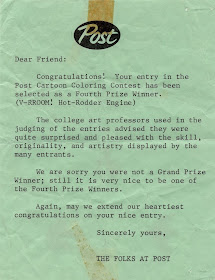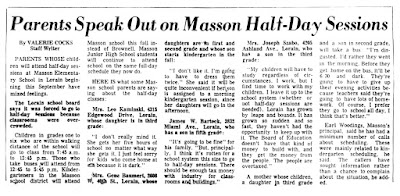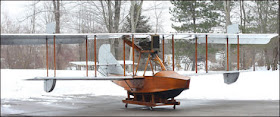Well, of course I had to dig out my contest entry from storage, and do a little online research about the 1966 competition itself.
As it turns out, it was really more of a coloring contest. On the back of special Post Cereals boxes, a cartoon picture featuring one of the brand’s advertising mascots appeared, surrounded by copious amounts of white space. The idea was that kids would finish the drawing and color it all in.
Here’s the back of a Post Toasties box (courtesy of Ebay) with one of the pictures. This one features Billie Bird, one of the characters (voiced by Carl Reiner) on the Linus the Lionhearted TV show.
As you can see, a Mattel V-RROOM engine is one of the fourth prizes.
Anyway, my entry was from the back of a box of Alpha-Bits. Here’s what the front of a typical box (with Lovable Truly the Postman) looked like at that time.
I’m not sure why, but for some reason I redrew my entry instead of using the one on the box. Mom helped me with the words that I wanted to come out of Lovable Truly’s mouth: “I’m always in a hurry to get my Alpha Bits.”
Here’s my entry.
I have no idea why I made Lovable Truly’s hair blue, or gave him red shoes. I also strongly suspect that I was thinking of Lucky Charms when I drew the big bowl of cereal.
And here's the little note from Post telling me I was a Fourth Prize Winner.
As for my prize, I remember watching Dad fasten the V-RROOM engine to my bike. It was pretty noisy and I don’t think I used it very long.
And here's the little note from Post telling me I was a Fourth Prize Winner.
As for my prize, I remember watching Dad fasten the V-RROOM engine to my bike. It was pretty noisy and I don’t think I used it very long.
Here’s what it looked like (courtesy of the online Museum of Vintage V-rroom Collectible Mattel Toys).
And here’s a great vintage commercial for it.
The real winner of all this was actually Post. I’m still eating Alpha Bits (and Sugar Crisp, er, I mean Golden Crisp) more than fifty years later!























































